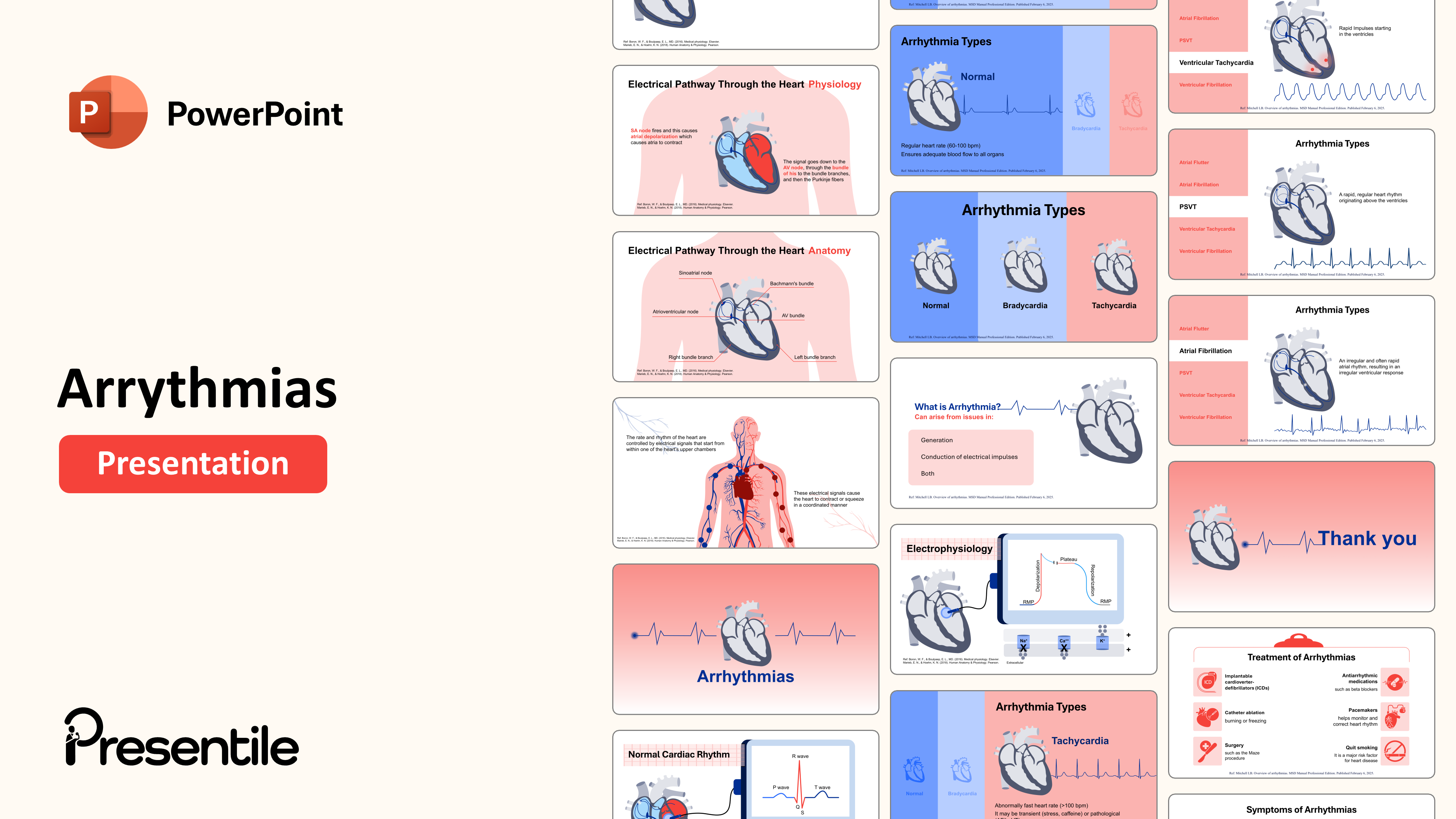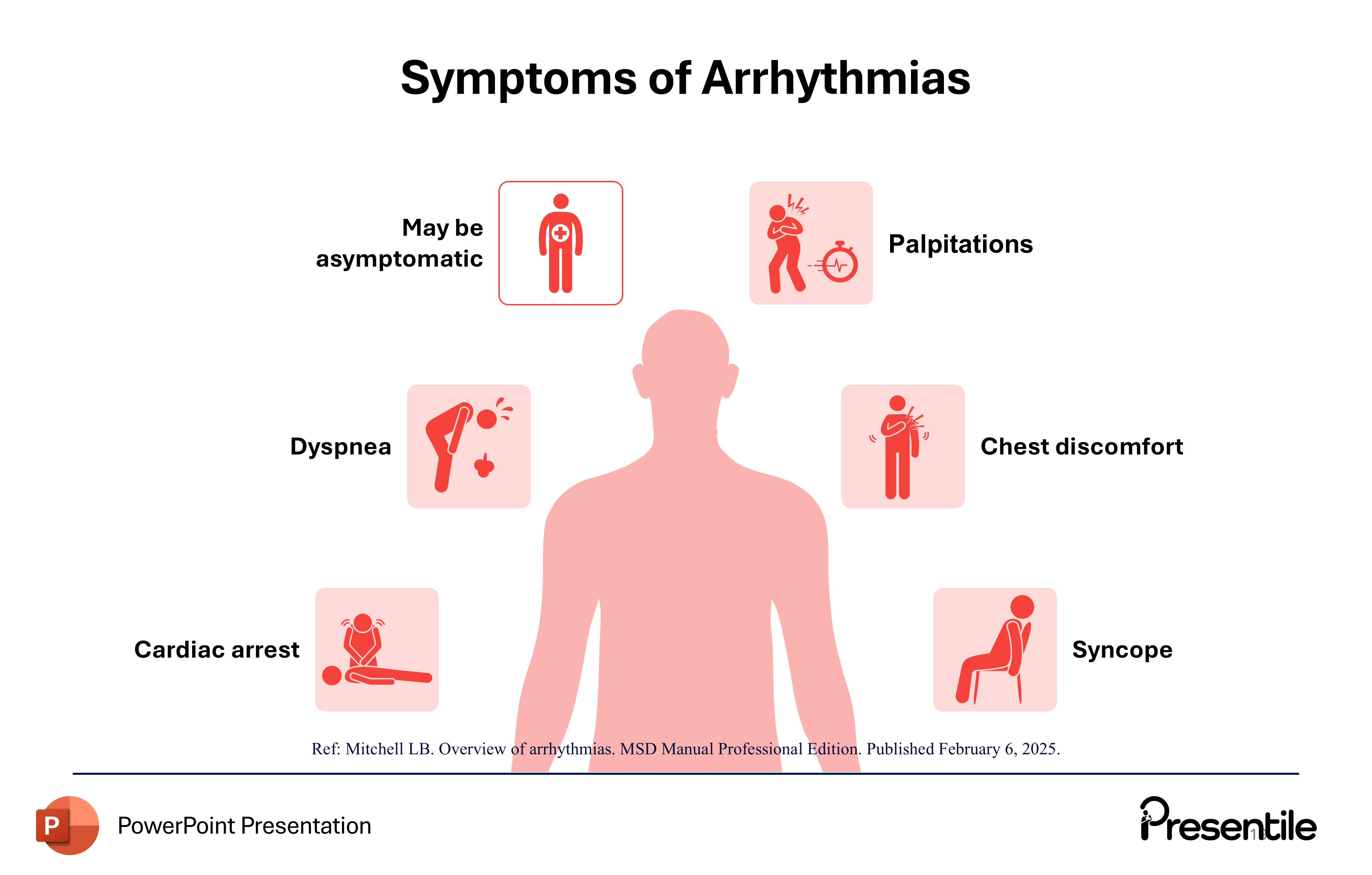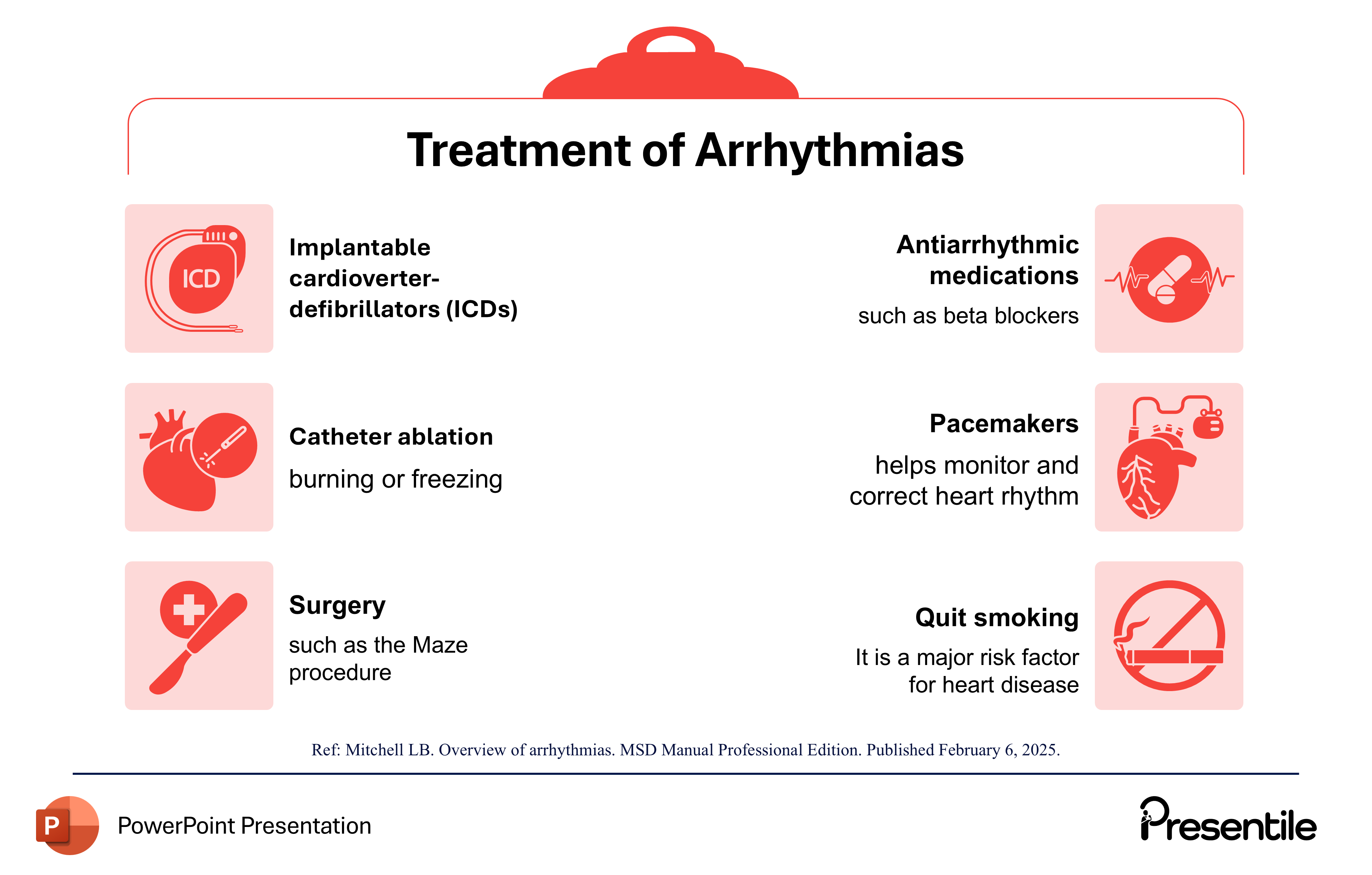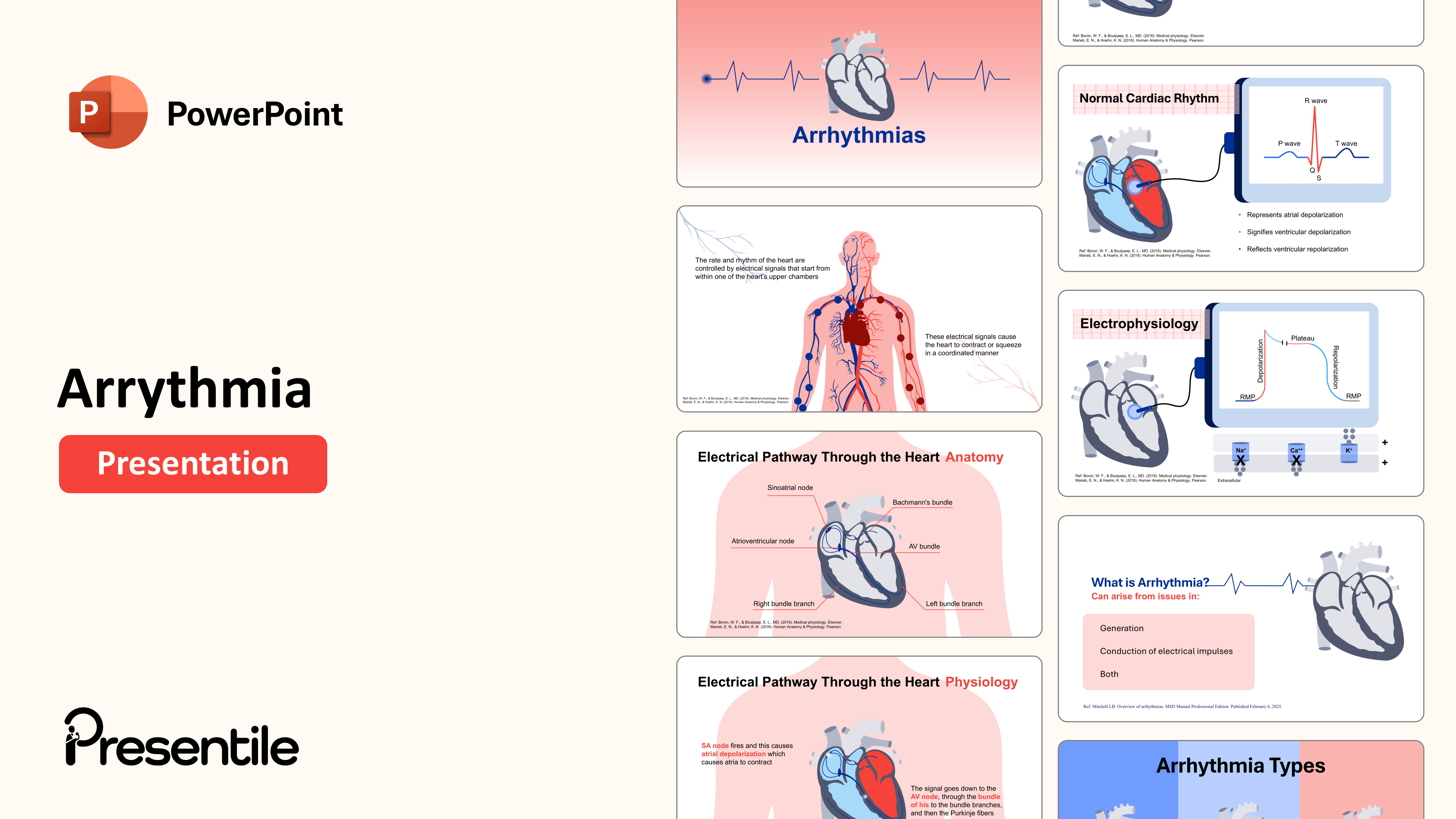
Content of
Arrhythmias Presentation
Slide 1: Arrhythmias (Title Slide)
.PNG)
This slide introduces a new presentation focused on Arrhythmias, or irregular heart rhythms.
- The topic, Arrhythmias, is clearly stated at the bottom center.
- The slide features a simple, stylized human heart at the center, flanked by an Electrocardiogram (ECG) trace showing an irregular rhythm (an arrhythmia).
- The background uses a soft, reddish-pink gradient, evoking a sense of urgency related to the heart.
Slide 2: The Heart's Electrical System and Contraction

This slide introduces the fundamental mechanism of the heart's function: its electrical control and resulting mechanical action. It establishes the normal process that is disrupted by an arrhythmia.
- A clear, stylized illustration of the human cardiovascular system, showing the heart and the major arteries (red) and veins (blue).
- The rate and rhythm of the heart are controlled by electrical signals that start from within one of the heart's upper chambers. This refers to the Sinoatrial (SA) node, the natural pacemaker .
- These electrical signals cause the heart to contract and squeeze in a coordinated manner. This describes how the electrical impulse translates into the synchronized muscle contraction (the heartbeat) that pumps blood throughout the body.
Slide 3: Electrical Pathway Through the Heart (Anatomy)
.PNG)
This slide provides a labeled diagram of the heart's intrinsic electrical conduction system, which controls the rhythm. This is the crucial anatomical detail that lays the groundwork for explaining where arrhythmias originate.
The visual highlights the key components of the system in the heart muscle:
- Sinoatrial node (SA node): The primary natural pacemaker, located in the right atrium.
- Atrioventricular node (AV node): Acts as a gate, delaying the electrical signal from the atria to the ventricles.
- Bachmann's bundle: A pathway that connects the right and left atria.
- AV bundle (Bundle of His): Connects the AV node to the bundle branches.
- Right bundle branch
- Left bundle branch
Slide 4: Electrical Pathway Through the Heart (Physiology)
.PNG)
This slide explains the sequence of electrical events (depolarization and impulse propagation) that results in a normal heartbeat. It uses the same heart diagram but highlights the process.
- Atrial Depolarization: "SA node fires and this causes atrial depolarization which causes atria to contract". This explains the first step where the primary pacemaker initiates the heart cycle and causes the upper chambers to pump blood to the ventricles.
- Ventricular Conduction: "The signal goes down to the AV node, through the bundle of his to the bundle branches, and then the Purkinje fibers". This details the pathway that leads to ventricular contraction, which is the major pumping action of the heart.
Slide 5: Normal Cardiac Rhythm

This slide defines the normal, healthy rhythm of the heart, contrasting it with the irregular rhythms (arrhythmias) that are the focus of the presentation.
- The electrical impulse originates from the sinoatrial node, leading to regular and coordinated atrial and ventricular contractions. This summarizes the normal sequence established in the preceding slides (Anatomy and Physiology).
- Visual Elements:
- The heart diagram shows the electrical signal originating in the SA node.
- A prominent Electrocardiogram (ECG) trace box displays a typical normal sinus rhythm, characterized by regular P waves, QRS complexes, and T waves.
Slide 6: Normal Cardiac Rhythm (ECG Components)
.PNG)
This slide elaborates on the components of the normal ECG trace, defining what each wave and segment represents physiologically. This is crucial for understanding how deviations in these components signify an arrhythmia.
- P wave: Represents atrial depolarization (electrical activation of the atria, causing them to contract).
- QRS complex (Signified by R wave): Signifies ventricular depolarization (electrical activation of the ventricles, causing the main pump to contract).
- T wave: Reflects ventricular repolarization (the electrical recovery phase of the ventricles).
Slide 7: Electrophysiology (Action Potential)
.PNG)
This slide details the cardiac action potential, explaining the physiological basis of the electrical events shown on the ECG. This is a fundamental concept for understanding how drugs and disease affect rhythm.
- Action Potential Curve: The graphic displays the cardiac action potential phases: Depolarization, Plateau, and Repolarization, returning to the Resting Membrane Potential (RMP).
- Below the curve, the slide illustrates the key ions involved in these phases:
- Na+ (Sodium): Critical for rapid Depolarization.
- Ca++ (Calcium): Responsible for the Plateau phase, sustaining the contraction.
- K+ (Potassium): Responsible for Repolarization.
Slide 8: What is Arrhythmia?

This slide provides the central definition of an arrhythmia and categorizes its underlying causes based on the heart's electrical system.
- Definition: The slide poses the question, "What is Arrhythmia?" and provides the core concept.
- Categories of Causation: Arrhythmias can arise from issues in:
- Generation: Problems with the rate or source of the electrical impulse (e.g., the SA node firing too fast or too slow, or an ectopic focus firing).
- Conduction of electrical impulses: Problems with the transmission of the impulse (e.g., a block in the AV node or bundle branches).
- Both: A combination of generation and conduction issues.
Slide 9: Arrhythmia Types

This slide introduces the fundamental clinical classification of arrhythmias based on whether the heart rate is normal, too slow, or too fast. The visual presents three heart icons on colored panels to distinguish the types.
- Normal: Represents a heart operating at a typical, healthy rhythm and rate.
- Bradycardia: Refers to heart rhythms that are too slow (typically below 60 beats per minute).
- Tachycardia: Refers to heart rhythms that are too fast (typically above 100 beats per minute).
Slide 10: Arrhythmia Types (Normal)
.PNG)
This slide focuses on detailing the characteristics of a normal heart rhythm, which is the baseline for identifying an arrhythmia. The visual frames the normal ECG trace within the blue section of the classification slide.
- Regular heart rate: The normal rate is defined as 60-100 beats per minute (bpm).
- Function: A normal rate ensures adequate blood flow to all organs. This links the electrical rate to the mechanical outcome (perfusion).
Slide 11: Arrhythmia Types (Bradycardia)
.PNG)
This slide focuses on defining bradycardia, its characteristic ECG features, and its common causes. It uses a light blue background and a heart rate trace that is visibly slower than the normal rhythm.
- Definition: Bradycardia is a slow heart rate (<60 bpm).
- Causes: It is typically caused by damage to heart tissue from aging or other heart conditions, or by some medications. This highlights both pathological and iatrogenic causes.
- ECG Visual: The trace shows a slow, regular rhythm, which is the hallmark of many bradyarrhythmias.
Slide 12: Arrhythmia Types (Tachycardia)
.PNG)
This slide defines tachycardia, its characteristic features, and its diverse causes, completing the introduction to the two primary rate-based arrhythmia categories. It uses a pink/red background and a heart rate trace that is visibly faster than the normal rhythm.
- Definition: Tachycardia is an abnormally fast heart rate (>100 bpm).
- Causes: It may be transient (caused by non-pathological factors like stress, caffeine) or pathological (caused by heart disease, such as Atrial Fibrillation - AFib, or Ventricular Tachycardia - VT).
- ECG Visual: The trace shows a rapid, regular rhythm, which is typical of many tachyarrhythmias.
Slide 13: Arrhythmia Types (Specific Tachyarrhythmias)
.PNG)
This slide introduces the names of five specific types of tachyarrhythmias, categorized by their location of origin, and provides corresponding ECG traces to illustrate their unique rhythms. This is the natural progression from the general "Tachycardia" definition.
The slide lists the five rhythms on the left, which are the main focus of the subsequent detailed discussion:
- Atrial Flutter
- Atrial Fibrillation (AFib)
- PSVT (Paroxysmal Supraventricular Tachycardia)
- Ventricular Tachycardia
- Ventricular Fibrillation (VFib)
Slide 14: Arrhythmia Types (Atrial Flutter)
.PNG)
This slide details the first specific tachyarrhythmia, Atrial Flutter, which is a common supraventricular arrhythmia. The visual focuses the electrical conduction on the atria, indicating its origin.
- Definition/ECG Feature: Atrial Flutter is characterized by a rapid, regular atrial rhythm with a characteristic 'sawtooth' pattern on the ECG.
- Mechanism: This rhythm is typically caused by a re-entry circuit in the right atrium, leading to rapid, repetitive depolarization of the atria.
- Visual: The ECG trace at the bottom shows the P waves replaced by rapid, flutter waves (the "sawtooth" pattern).
Slide 15: Arrhythmia Types (Atrial Fibrillation)
.PNG)
This slide details Atrial Fibrillation (AFib), the most common sustained arrhythmia, characterized by its rapid and irregular rhythm. The visual highlights the atria, showing disorganized electrical activity.
- Definition/ECG Feature: Atrial Fibrillation is an irregular and often rapid atrial rhythm, which results in an irregular ventricular response.
- Mechanism: This is caused by multiple chaotic electrical impulses originating in the atria, preventing coordinated contraction and leading to uncoordinated ventricular beats.
- Visual: The ECG trace shows the characteristic chaotic baseline (no discernible P waves) and irregularly spaced QRS complexes, which is the hallmark of AFib.
Slide 16: Arrhythmia Types (PSVT - Paroxysmal Supraventricular Tachycardia)
.PNG)
This slide details PSVT, a rapid, regular rhythm that originates above the ventricles, often starting and stopping abruptly. The visual shows a heart with the conduction system highlighted.
- Definition/Mechanism: PSVT is characterized as a rapid, regular heart rhythm originating above the ventricles. The "paroxysmal" nature means it can start and stop suddenly.
- Origin: The rhythm starts somewhere above the ventricles (supraventricular), often involving the AV node or an accessory pathway.
- Visual: The ECG trace shows a rapid, usually narrow-complex (ventricular) rhythm, confirming its classification as a tachycardia.
Slide 17: Arrhythmia Types (Ventricular Tachycardia)
.PNG)
This slide details Ventricular Tachycardia (VT), a potentially life-threatening arrhythmia originating in the lower chambers of the heart. The visual highlights the ventricles as the source of the electrical problem.
- VT is characterized by rapid impulses starting in the ventricles. When sustained, this rhythm can severely impair the heart's ability to pump blood effectively.
- The electrical focus is clearly shown originating in the ventricular muscle.
- The ECG trace shows wide, rapid, and regular complexes, reflecting the abnormal, uncoordinated electrical activity in the ventricles.
Slide 18: Arrhythmia Types (Ventricular Fibrillation)
.PNG)
This slide details Ventricular Fibrillation (VFib), the most chaotic and immediately life-threatening arrhythmia that leads to cardiac arrest. The visual illustrates disorganized electrical signals throughout the ventricles.
- VFib is caused by chaotic electrical signals that cause the ventricles to quiver or fibrillate rather than contract. Because the ventricles are only quivering, they cannot pump blood, leading to immediate circulatory collapse.
- The problem is widespread and disorganized electrical activity throughout the ventricles.
- The ECG trace shows a completely disorganized, chaotic, wavy line, which is known as coarse or fine VFib. Clinically, this pattern signifies pulselessness.
Slide 19: Symptoms of Arrhythmias

This slide outlines the common clinical symptoms experienced by patients with an arrhythmia, ranging from mild discomfort to life-threatening emergencies. The visual shows a central figure surrounded by icons depicting various symptoms.
- May be asymptomatic: The presence of an arrhythmia, particularly a mild or transient one, may go unnoticed by the patient.
- Palpitations: A common symptom described as a feeling of a skipped, fluttering, or rapid heartbeat.
- Dyspnea: Shortness of breath, often caused by the heart's inability to pump blood efficiently at the abnormal rate/rhythm.
- Chest discomfort: Pain or tightness in the chest area.
- Syncope: Fainting or temporary loss of consciousness, often due to a rapid rhythm (tachycardia) that prevents the heart from adequately filling and supplying blood to the brain.
- Cardiac arrest: The most severe outcome, especially with rhythms like Ventricular Fibrillation (VFib).
Slide 20: Treatment of Arrhythmias

This slide provides a comprehensive overview of the different therapeutic approaches used to manage arrhythmias, including pharmacological, procedural, and surgical options, as well as prevention. The visual uses six icons to categorize the interventions.
- Implantable cardioverter-defibrillators (ICDs): These devices are used to monitor and deliver an electrical shock (cardioversion/defibrillation) to correct a dangerous rhythm.
- Catheter ablation: A procedure that uses burning or freezing to destroy small areas of heart tissue that are causing the irregular electrical signals.
- Surgery: This is sometimes necessary, such as the Maze procedure, to create scar tissue that blocks abnormal electrical pathways.
- Antiarrhythmic medications: Drugs, such as beta blockers, are used to control the heart rate and rhythm.
- Pacemakers: These devices help monitor and correct heart rhythm, especially for bradyarrhythmias (slow rhythms).
- Quit smoking: This is a lifestyle change emphasized as it is a major risk factor for heart disease and subsequent arrhythmias.
Slide 21: Thank You (Conclusion)
.PNG)
This slide serves as the concise and professional conclusion to your comprehensive presentation on Arrhythmias.
The visual prominently features the heart graphic and an ECG trace leading to the formal sign-off: "Thank you".
Features of
Arrhythmias Presentation
- Fully editable in PowerPoint
- All graphics are in vector format
- Medically Referenced information and data
 Slides count:
Slides count: Compatible with:Microsoft PowerPoint
Compatible with:Microsoft PowerPoint File type:PPTX
File type:PPTX Dimensions:16:9
Dimensions:16:9




